There are several reasons one can feel tired. Some people feel worn out after doing difficult tasks or accomplishing tall orders, which is normal. While, some people feel tired even without doing anything, which can be problematic in the long run. And some get tired after long periods of sitting and working. Whatever be the reason; prolonged tiredness can lead to many other problems, like lethargy, low feelings, boredom, etc. However, practicing yoga to remove tiredness can help you relieve stress and anxiety and have improved physical health.
Yoga to remove tiredness is an excellent yoga sequence which unblocks the stuck blocks of energy along the spine. With each yogic posture, you bring life force or Prana, into the back and other areas of the body. These active yoga poses will stimulate the blood flow through the body and energize the nervous system. This in turn helps you counter negative effects of long periods of sitting, combat lethargy and boost feelings of exuberance.
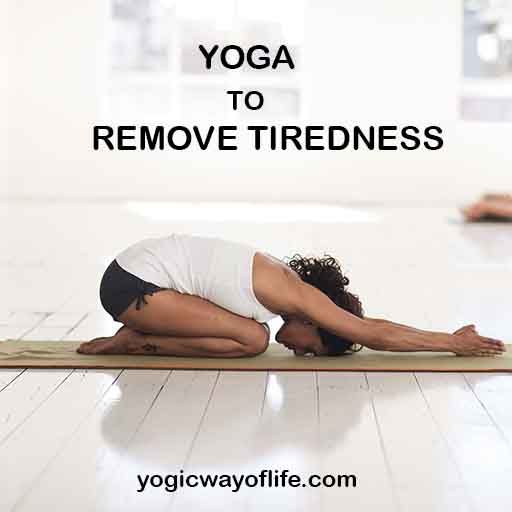
If you also feel tired all day long, then this post is for you. Here we are sharing the 7 best yoga poses to remove tiredness and feel energetic throughout the day.
Let’s get started….
Bitilasana – Marjariasana or The Cat-Cow Pose
Yoga to remove tiredness sequence starts with the cat cow pose. This is an excellent pose for massaging the spine and back muscles, and stimulating the flow of energy and circulation.
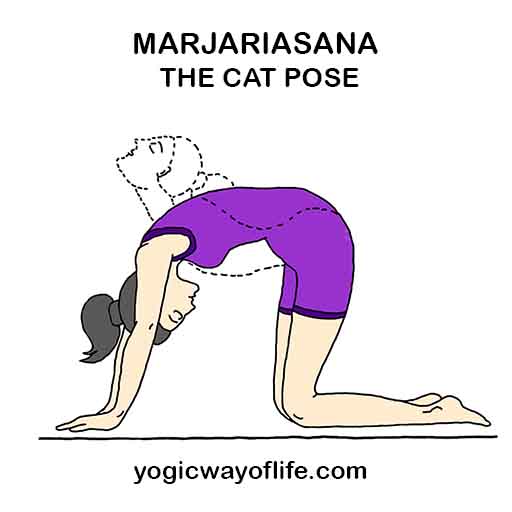
Instructions:
Get on all your fours, place your wrists under shoulders, and your knees under the hips. Balance your weight between all fours. Now inhale, scoop your back, and lift your head and chest up. Hold for at least 3 seconds. While exhaling, round your back as you tuck your chin to your chest, pull your naval towards your spine and arch it towards the ceiling, and look down. Hold this position for 3 seconds. Practice this pose for 5 to 10 times, in a slow, controlled way, coordinating each movement with the breath to reap the maximum benefits.
Balasana or Child Pose
The second pose in the yoga to remove tiredness sequence is Balasana. Balasana or the Child Pose is an excellent forward bending yoga asana. This pose deeply calms your mind, lengthens the back body, hips and reduces fatigue and tiredness.
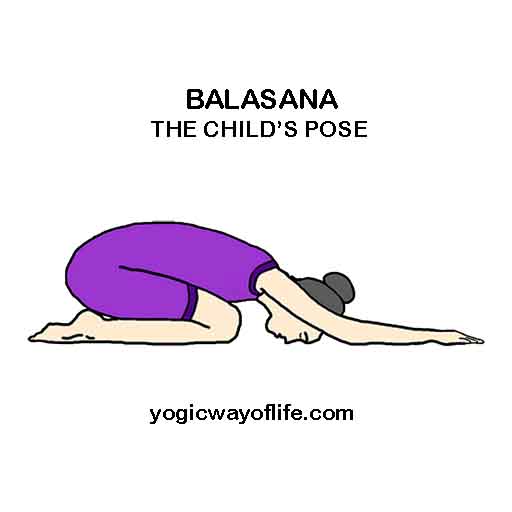
Instructions:
Start with the kneeling position, while keeping your feet and toes together. Now, spread your knees slightly apart. Inhale slowly and deeply. Slowly bend forward and let your chest rest between the thighs. Exhale as you are bending down. Let your hands be in front of you and resting on the floor, palms facing the mat. Adjust your pelvis and sacrum in such a way that your abdomen rests between the inner thighs and the back is stretched forward. Make sure your forehead rests on the floor and palms facing downwards, fully touching the mat. The arms should be in line with the knees and fully stretched out and relaxed. Use a pillow for support if you have difficulty resting the forehead on the floor. Breathe normally in this position and feel the deep relaxation. Remain in this position for as long as you are comfortable. To exit, move your hands back and slowly raise yourself up to the kneeling position.
Ushtrasana or The Camel Pose
The next pose in the yoga to remove tiredness sequence is Ushtrasana.
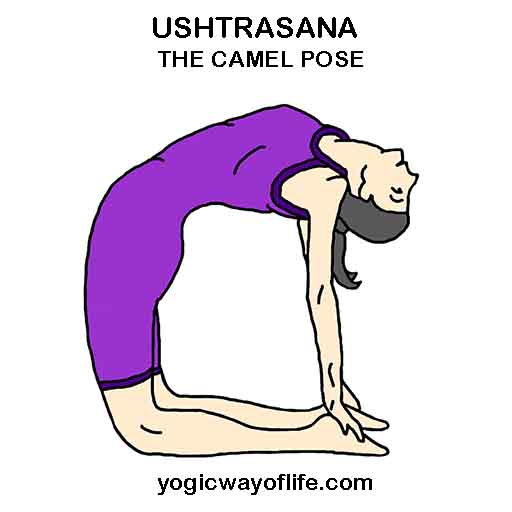
Ushtrasana or Camel pose is also an excellent pose of yoga to remove tiredness. It is a heart opener and a deep backward bend pose performed while kneeling. This spinal and hip stretch opens up the front of the body, activates and stimulates the thyroid gland.
Instructions:
Sit down in Vajrasana. Inhale and lift your body from the heels and come into a kneeling position. Let the tops of your feet rest on the floor/mat. Extend your toes backward. Inhale and lift your arms to the ceiling. On an exhale, push your hips forward. Inhale, engage the core and squeeze the muscles of the buttocks. On the next exhalation, hold the respective ankles of the feet, one at a time. Roll the shoulders backward and keep pushing the hips forward. Tilt the head backward as much as possible. Hold the posture for 10 deep breaths.
Virabhadrasana or The Warrior Pose
The next pose in the yoga to remove tiredness sequence is Virabhadrasana.
Virabhadrasana or the warrior pose is named after the legendary warrior Virabhadra in the Puranas. This is an excellent pose for relieving stress and improving nervous balance of the body.
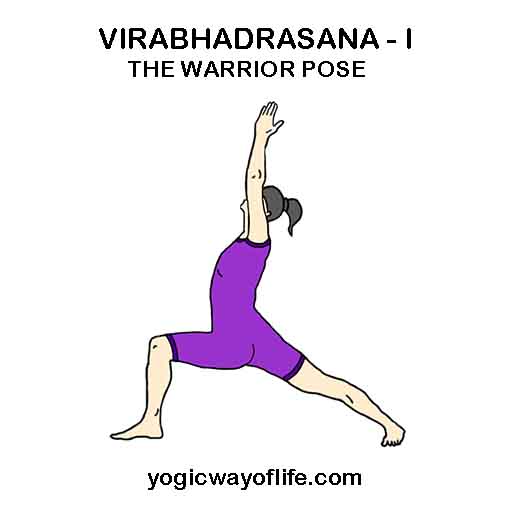
Instructions:
Stand straight with your legs spread out. Let there be a distance of at least 3 feet between the two feet. Raise your hands above the head with your palms facing each other. Turn to your left and slowly rotate the left foot about 90 degrees to the left so that it is aligned with the chest. Turn the right foot slightly (around 15 degrees) towards the inside. Bend your left knee and let your thighs be parallel to the ground. However, the right leg should remain straight. Your head, chest, left knee and the left foot should be aligned in one direction. Now bring your palms closer so that they touch each other. Keep breathing slowly and deeply, stay in this position for a few breaths. To exit, raise yourself up and straighten the left knee. Turn to the right to go back to the original position. Repeat this on the other side too.
Trikonasana or The Triangle Pose
Trikonasana or the Triangle Pose is a good stretching exercise. This pose gives flexibility to the spine, legs, waist, knees and pelvic region. It is an excellent posture to develop both strength and balance. Trikonasana is a good workout to get the blocked energies moving and relieve depression.
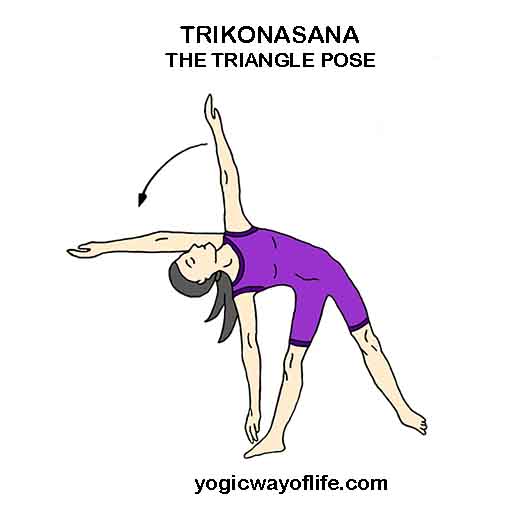
Instructions:
Stand straight with your legs spread out about 3 feet apart with knees straight. Inhale, now raise both your hands till they are in line with each other, parallel to the ground. Now exhale and bend towards your right, you can slightly bend your knees, to touch the right foot with the hands. Look up at the left hand. Keep your eyes open throughout the practice. To exit, return to the standing position. Now repeat this with the left hand touching the left foot. This is one round. You can practice as many rounds as you are comfortable.
Shalabhasana or Locust Pose
Shalabhasana or the Locust Pose is considered one the best yoga poses for strengthening the back muscles. It helps relieve lower back pain and strengthens the back torso, arms, and legs.
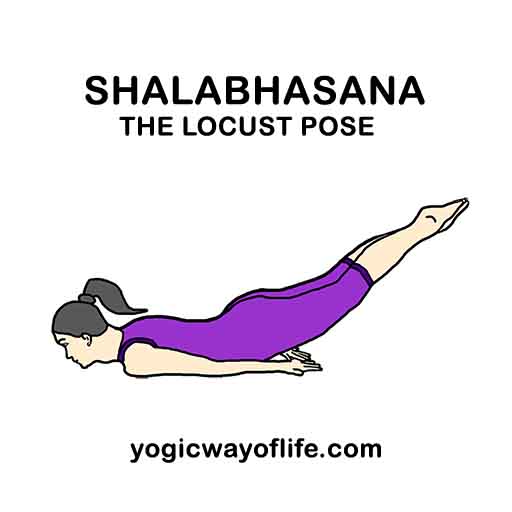
Instructions:
Lie on your stomach with the chin stretched and touching the ground. Keep your arms next to your torso. Slowly bring your hands under your legs for support. Take a deep breath and lift your right leg upwards, without bending your knees. Be in this position from a few seconds to half a minute. Exhale, and slowly release the position and bring down the right leg back to the original position. Rest for a few seconds. Keep breathing normally and deeply. Now, try the position with your left leg lifted above the ground. You can try this pose quite a few times.
PRANAYAM
Finally, performing pranayama after the yoga session is very good for one’s overall health. Pranayama is an excellent breathing exercise for overall health. It helps you release any kind of anxiety and strengthens your energy positively. Pranayama is a great way of energizing the body and mind simultaneously. Perform these two pranayams to conclude your yoga to remove tiredness sequence.
Sheetali Pranayama or The Cooling Breath
Sheetali Pranayama or the cooling breath is usually done after practicing yoga asanas. Sheetali Pranayama creates a cooling effect on the body and relaxes the mind.
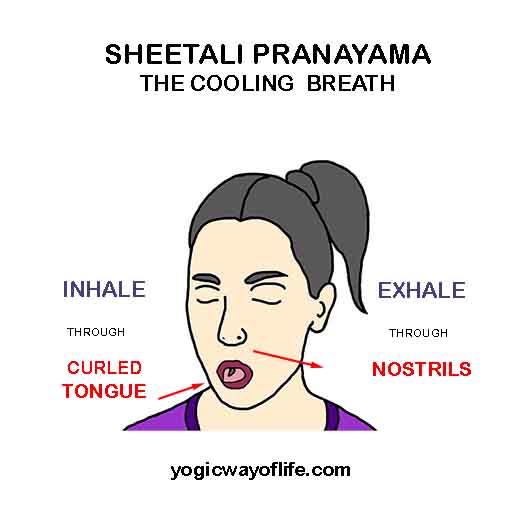
Instructions:
Sit in a comfortable asana and place your palms on the knees. Now roll your tongue from the sides, forming a narrow tube of tongue. The tongue will be folded from both sides, with the edges almost meeting at the center on the top. Slowly inhale, first fill in the abdomen region, then the chest and finally the neck region. This is the complete yogic breath. Pull your tongue inside the mouth and close your mouth. Now bend your neck forward to do the chin lock, also called the Jalandhara Bandha. Hold your breath for as much as you are comfortable. Now release Jalandhara Bandha and exhale slowly through the nose. This is one round of Sheetali Pranayama. You can do as many rounds as you may feel comfortable.
Surya Bheda Pranayama or The Vitalizing Breath
Surya Bheda Pranayama or the Vitalizing Breath, is one of the main pranayams practiced with Kumbhaka. In Surya Bheda Pranayama the Surya Nadi or the right nostril channel is activated.
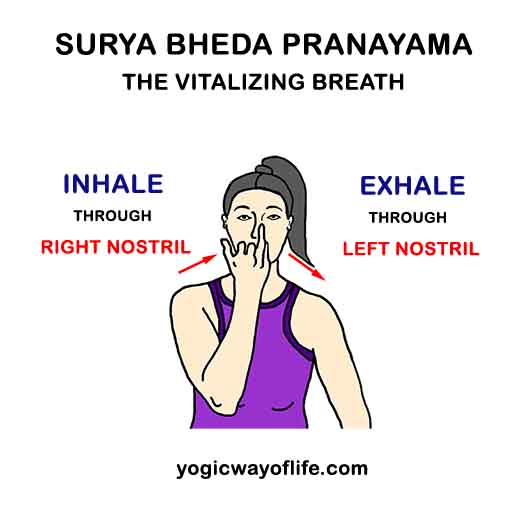
Instructions:
Sit in a meditative asana, preferably Padmasana, Siddhasana or Vajrasana. Keep your trunk and spine straight and place your hands on the knees. Take a few relaxed breaths before you start the practice. Now raise your right hand and place your forefinger and the middle finger on your forehead between the eyebrows. Now with your ring finger close your left nostril. Slowly inhale through your right nostril and fill in your lungs completely. Now close your right nostril with the thumb and the left nostril with your ring finger and hold the breath.
Now perform Jalandhara Bandha (the chin lock) and Mula Bandha. Try to hold your breath as long as you are comfortable. Gradually release your Bandha, first Mula and then Jalandhara Bandha and exhale through your left nostril (Ida Nadi), while keeping your right nostril closed. This completes one round. Repeat as many rounds as comfortable.
Shavasana or The Corpse Pose
Yoga to remove tiredness should be concluded with Shavasana. Shavasana is the best asana to calm your mind, release any kind of stress in the body and sink in all the asanas at a deeper level.
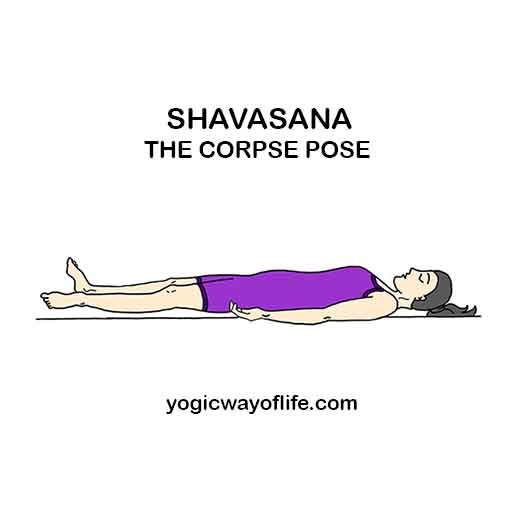
Instructions:
Lie down on your back with your legs spread apart. Now, place your arms beside your body facing upwards. Take deep breaths. Stay in the pose for at least 2 minutes and then release the pose.
